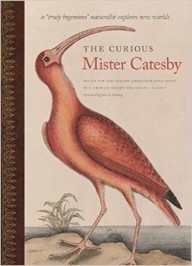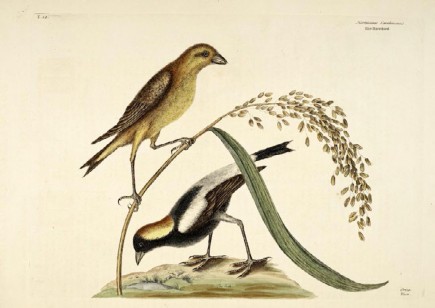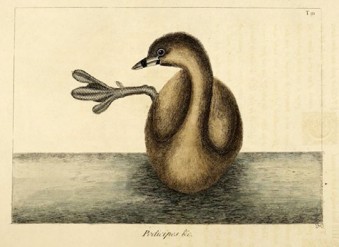Mark Lynch
The Curious Mister Catesby. Edited for the Catesby Commemorative Trust by E. Charles Nelson and David J. Elliott. 2015. Athens, Georgia: University of Georgia Press.
In American birding circles Mark Catesby (1683–1749) lacks the name recognition or cachet of John James Audubon or Alexander Wilson. There are no shearwaters or petrels named after him. Even to those familiar with Catesby’s published work, the man remains a shadowy figure. There are no portraits of him, the details of his life are spare, and the few written descriptions of the man seem contradictory and add to the mystery of who he was.
“He was so merry, he sang,” wrote William Byrd, Catesby’s host in Virginia. Others describe Catesby as sullen, grave and sedate, modest, honest, affable, or simply tall. Without much else to go on, the reader cannot help but picture Mark Catesby as some kind of nature-loving Abraham Lincoln. We are left deducing the qualities of the man from the details of his artwork and anecdotes from his written work.
For instance, he decided to check out the stories about the manchineel tree for himself:
but the virulent and dangerous Properties of these Trees, causes a general Fear, or at least Caution, in felling them; this I was not sufficiently satisfied of, ‘till assisting in the cutting down a Tree of this Kind on Andros Island, I paid for my Incredulity, some of the milky poisonous Juice spurting in my Eyes, I was two Days totally deprived of Sight, and my Eyes, and Face, much swelled, and I felt a violent pricking Pain, the first twenty-four Hours, which from that Time abated gradually with the Swelling, and went off without any Application, or Remedy, none in that uninhabited Island being to be had.” (p. 214)
Catesby certainly appears to be curious, at times even fearless, and possessing a true scientist’s need to get at the truth behind the stories. But is this just my reading into this quote or what he was really like? Cynthia P. Neal, the producer and director of a documentary titled “The Curious Mister Catesby,” says this about the man: “Aside from all else that I admire about Mark Catesby, the one characteristic that stands above all the rest is his phenomenal powers of observation and recall.” (p. 25)
 These qualities can be inferred by looking at his artwork or reading his text.
These qualities can be inferred by looking at his artwork or reading his text.
An outline of his life is as follows. Mark Catesby was born on March 24, 1683, and baptized in Castle Hedingham, England. Catesby lived at a time in a Britain that experienced amazing advances in scientific knowledge while also exploring some of the farthest reaches of the globe. London itself was in the midst of a building renaissance. The great fire of 1666 had leveled large areas of the city, and during Catesby’s life, London was being reimagined by architects like Christopher Wren.
Catesby traveled to Virginia for the first time in 1712. Little is known of what transpired in Virginia. He sent plants back to England, to Samuel Dale and Henry Compton, the Bishop of London. It was a common practice of the day to get sponsors to finance your trips in exchange for your sending eagerly sought specimens from the New World. Catesby sent many plant specimens to England, some that became popular in gardens and parks. These included the catalpa, the red maple and the magnolia. In 1714, he made trips to Jamaica and Bermuda. In 1716 he returned to England.
In 1722, he set sail for North America again, but this time under the “auspices of the Royal Society of London,” which was headed by Sir Isaac Newton at the time. He proposed a trip to Mexico in 1724, but this venture was not approved by his sponsors, a shame because one wonders what specimens he would have discovered there. He spent most of 1725 in the Bahamas and also visited Hispaniola and Puerto Rico. Catesby returned to England in 1726.
To record his observations of the plants, animals, and birds of the New World Catesby began to write what was to become his magnum opus, The Natural History of Carolina, Florida and the Bahama islands. Catesby apparently was not one to delegate responsibility, so he taught himself how to engrave. The plates for his book were produced in his own house by his own hand. Ultimately, he personally engraved each of the 220 plates and colored the prints, somewhere in the ballpark of 30,000 prints for the first edition. This figure seems nothing short of incredible, if not impossible.
The book was issued in parts, from 1 through 10. Part 1 was presented at the court to Queen Caroline in 1729. Part 10 was released in 1743. About 100 copies of this landmark book survive with another 100 copies considered lost.
Catesby’s book illustrates and describes the plants, birds, reptiles, amphibians, fish, crustaceans, gorgonians, and even a few insects that caught his interest during his travels. Now extinct, the Ivory-billed Woodpecker, the Passenger Pigeon, and the Carolina Parakeet were all described and illustrated by Catesby. The bullfrog (Rana catesbeiana), which he illustrated, was named later in his honor. Although most attention is paid to his mainland North American work, fully one-third of his illustrations show specimens from the Bahamas, and these are considered some of his best plates. He also illustrated seven species from Jamaica and twelve species from other localities. He drew preliminary drawings for the plates, and colored some on the spot. He worked on these after he returned from his expeditions, and, when finished, they became the basis for his plates.

The Ricebird (Bobolink) plate from Catesby’s Natural History
In 1747, he published and presented a short paper that remains a landmark in the history of ornithology. In 1725, while lying on the deck of a ship anchored off Andros Island in the Bahamas, he noted the flight calls of Bobolinks overhead for three nights. This got him to start thinking about “the apparent periodic seasonal absence of birds after the end of summer.” (p. 219) Up until then, people believed all sorts of odd notions about where certain species went in the winter months. For instance, it was commonly believed that swallows hibernated under the mud in ponds. Catesby’s paper titled “Of Birds of Passage” inspired a more scientific study of bird migration and the discovery that certain species of birds flew to other climates in winter.
Four years later he married Elizabeth Rowland, but died just two years after that. “His burial place at St. Luke’s Church, Old Street, London, is no longer known.” (p. ix) Mark Catesby was clearly an extraordinary person who traveled widely in the New World. He drew and wrote about the natural wonders he found there, but the personal details of what he was like will always be frustratingly out of reach.
The Curious Mister Catesby is a collection of twenty-two papers presented to the Catesby Commemorative Trust and written by leading experts in their fields. It is a stunning volume. “The objective of this book is to review the life and work of Mark Catesby in a way that will be valuable both to the interested and informed general reader and to the scholarly community.” (p. xi) Because so little is known about the person, the authors approach the subject of Catesby from various, sometimes peripheral, perspectives. Several of the papers concentrate on naturalists that came before Catesby and either definitely or possibly influenced the way he looked at the natural world. These include naturalists like John Banister and Maria Sibylla Merian.

The Pied-billed Grebe plate from Catesby’s Natural History
I have a confession. I almost forgot about Catesby entirely when I read the essay on William Dampier (1651–1715) by Diana Preston and Michael Preston (pp. 57–70). Dampier was a pirate/naturalist who began his life sailing the Spanish Main and keeping notes on the world he saw. Later he left buccaneering and became a full-time natural historian and hydrographer and also became the first naturalist to visit five continents. There is a great portrait of the dashing Dampier included in the essay and he looks every bit the rogue naturalist. A fine role model if there ever was one.
Other papers found in The Curious Mister Catesby focus on such varied topics as how he made drawings in the field, his many contributions to botany, his work in the Caribbean, a behind the scenes look at the aforementioned documentary of his life, and of course the legacy of Catesby—later naturalists who were inspired by Catesby. The book is profusely illustrated with color plates, including many examples of Catesby’s work. Though the focus of a number of essays is on his botanical discoveries, much attention is paid to his bird work, and an entire chapter is about his seminal paper, “Of Birds of Passage.”
Though Catesby’s bird plates may lack the overt drama of Audubon’s large format plates, Catesby’s birds are quite lively and beautifully composed. He often included a plant with the bird. This book will likely encourage a re-evaluation of Catesby’s artistic endeavors, particularly his illustrations from the Bahamas.
The Curious Mister Catesby is a sumptuous scholarly volume that will introduce the reader to a deeper understanding of who Mark Catesby was and what he accomplished. It is a must-have book for anyone interested in the history of North American natural history.